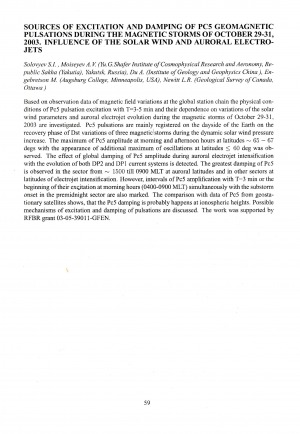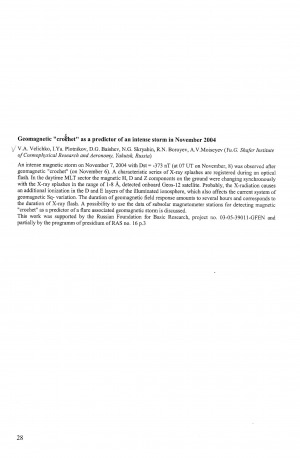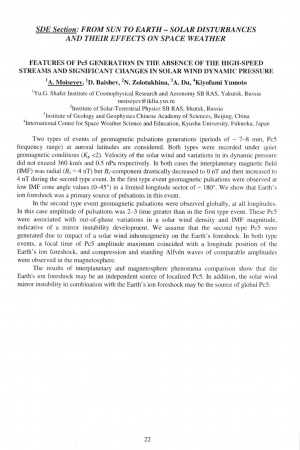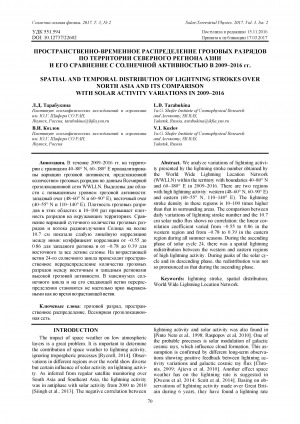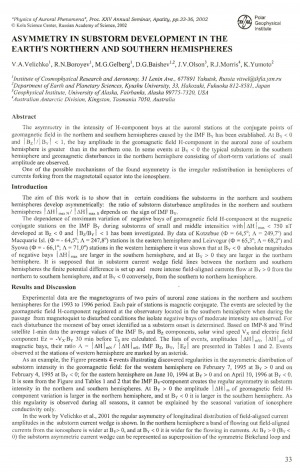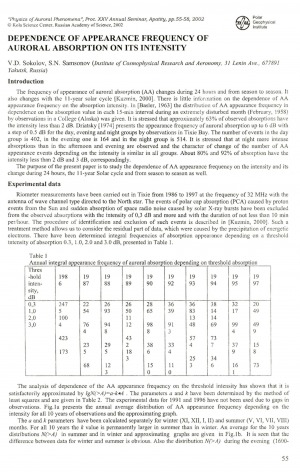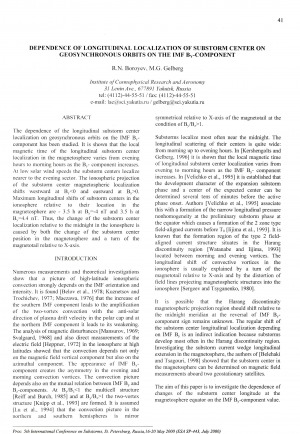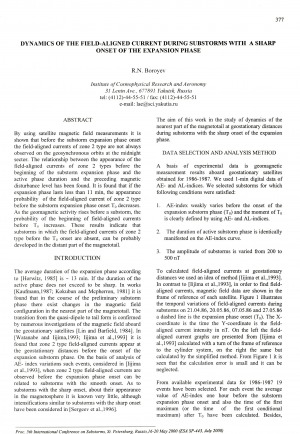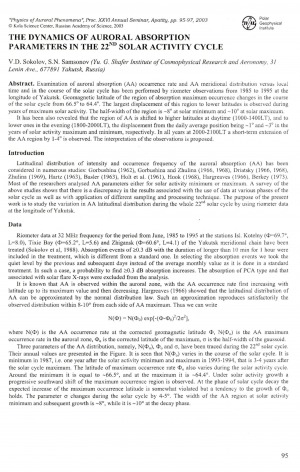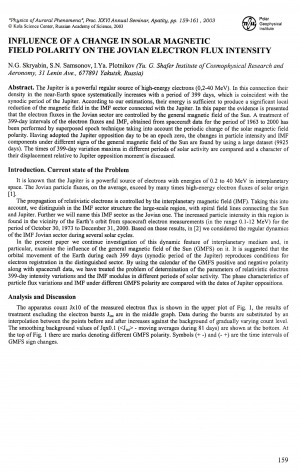Образован в 1962 г. распоряжением Совета Министров РСФСР N 3807-р об организации на базе Якутской геофизической обсерватории ЯФ СО АН СССР самостоятельного академического учреждения - Института космофизических исследований и аэрономии СО АН СССР. В 2003 г. постановлением Президиума РАН присвоено имя его основателя профессора Ю. Г. Шафера.
Количество страниц: 1 с.
Sources of excitation and damping of PC5 geomagnetic pulsations during the magnetic storms of october 29-31, 2003 influence of the solar wind and auroral electrojets : [тезисы докладов] / Solovyev S. I., Moiseyev A. V., Du A., Engebretson M., Newitt L. R. // International symposium on Solar Extreme Events of 2003 : programme and abstract book. – Москва : УНЦ ДО, 2004. – P. 59.
Количество страниц: 2 с.
Geomagnetic "croshet" as a predictor of an intense storm in November 2004 : [тезисы докладов] / V. A. Velichko, I. Ya. Plotnikov, D. G. Baishev, N. G. Skryabin, R. N. Boroyev, A. V. Moiseyev // Physics of auroral phenomena : 29th annual seminar, 27 February – 3 March 2006 : abstracts. – 2006. – P. 28.
Количество страниц: 2 с.
Features of Pc5 generation in the absence of the high-speed streams and significant changes in solar wind dynamic pressure : [тезисы докладов] / A. Moiseyev, D. Baishev, N. Zolotukhina, A. Du, K. Yumoto // Physics of auroral phenomena : 26th annual seminar, 25-28 February 2003 : abstacts. – 2003. – P. 22.
Количество страниц: 5 с.
We analyze variations of lightning activity presented by the lightning stroke number obtained by the World Wide Lightning Location Network (WWLLN) within the territory with boundaries 40-80° N and 60-180° E in 2009-2016. There are two regions with high lightning activity: western (48-60° N, 60-90° E) and eastern (40-55° N, 110-140° E). The lightning stroke density in these regions is 10-100 times higher than that in surrounding areas. The comparison between daily variations of lightning stroke number and the 10.7 cm solar radio flux shows no correlation: the linear correlation coefficient varied from -0.55 to 0.86 in the western region and from -0.78 to 0.39 in the eastern region during all summer seasons. During the ascending phase of solar cycle 24, there was a spatial lightning redistribution between the western and eastern regions of high lightning activity. During peaks of the solar cycle and its descending phase, the redistribution was not so pronounced as that during the ascending phase.
Tarabukina, L. D. Spatial and temporal distribution of lightning strokes over North Asia and its comparison with solar activity variations in 2009-2016 = Пространственно-временное распределение грозовых разрядов по территории северного региона Азии и его сравнение с солнечной активностью в 2009-2016 гг. / L. D. Tarabukina, V. I. Kozlov // Солнечно-земная физика = Solar-Terrestrial Physics. – 2017. – Т. 3, N 2 : 13-я российско-китайская конференция по космической погоде. – С. 70-74.
DOI: 10.12737/22602
Количество страниц: 4 с.
Asymmetry in substorm development in the earth's northern and southern hemispheres / V. A. Velichko, R. N. Boroyev, M. G. Gelberg, D. G. Baishev, J. V. Olson, R. J. Morris, K. Yumoto // Physics of auroral phenomena : proceedings of the 25th annual seminar, Apatity, 26 February – 1 March 2002. – 2002. – P. 33-36.
Количество страниц: 4 с.
Sokolov, V. D. Dependence of appearance frequency of auroral absorption on its intensity / V. D. Sokolov, S. N. Samsonov // Physics of auroral phenomena : proceedings of the 25th annual seminar, Apatity, 26 February – 1 March 2002. – 2002. – P. 55-58.
Количество страниц: 4 с.
Boroyev, R. N. Dependence of longitudinal localization of substorm center on geosynchronous orbits on the IMF Bγ-component / R. N. Boroyev, M. G. Gelberg // Proceedings of the Fifth International Conference on Substorms : 16-20 May 2000 Congress Centre of the Arctic and Antarctic Research Institute, St. Petersburg, Russia. − Noordwijk, Netherlands : European Space Agency, 2000. − P. 41-44.
Количество страниц: 4 с.
Boroyev, R. N. Dynamics of the field-aligned current during substorms with a sharp onset of the expansion phase / R. N. Boroyev // Proceedings of the Fifth International Conference on Substorms : 16-20 May 2000 Congress Centre of the Arctic and Antarctic Research Institute, St. Petersburg, Russia. − Noordwijk, Netherlands : European Space Agency, 2000. − P. 377-380.
Количество страниц: 3 с.
Sokolov, V. D. The dynamics of auroral absorption parameters in the 22nd solar activity cycle / V. D. Sokolov, S. N. Samsonov // Physics of auroral phenomena : proceedings of the 26th annual seminar, 25 - 28 February 2003. – 2003. – P. 95-97.
Количество страниц: 3 с.
Skryabin, N. G. Influence of a change in solar magnetic field polarity on the Jovian electron flux intensity / N. G. Skryabin, S. N. Samsonov, I. Ya. Plotnikov // Physics of auroral phenomena : proceedings of the 26th annual seminar, 25 - 28 February 2003. – 2003. – P. 159-161.
